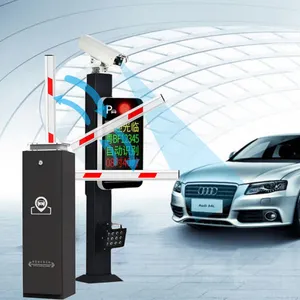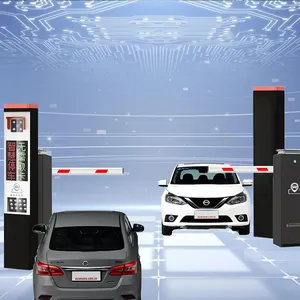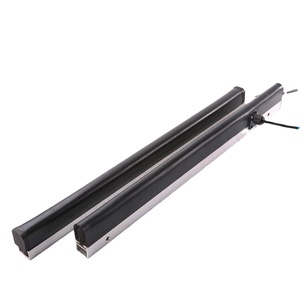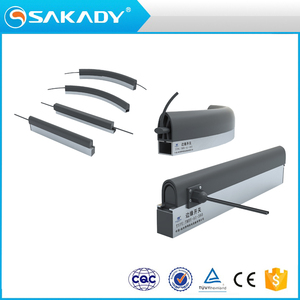(5277 products available)




















































































































































































































An automatic gate sensor is a device that allows gates to open and close automatically when it detects motion. Different types of sensors can be used for different applications. Here are the various types:
Magnetic Induction Sensors:
Magnetic induction sensors detect the change in magnetic field when an object is near. They work well in all weather conditions.
Infrared Sensors:
Infrared sensors work by dividing themselves into two categories: active and passive sensors. Active sensors create a beam that, when interrupted by an object, opens the gate. They are used in residential and commercial areas. They work well during the day and night. Active infrared sensors work well in high-traffic areas. They can also be installed in swinging or sliding gates. The only disadvantage is that they can malfunction when other animals pass through the beam. On the other hand, passive infrared sensors detect heat from humans and animals. They are installed in automatic gates and open when they sense motion. They are energy efficient and often used in automatic gates.
Photography Sensors:
Photocell sensors are light sensors that detect light levels. They provide different responses to light and dark environments. For example, during the day, they will open the gate when it is dark, and close it when it is light. They are used in commercial and residential settings. They are also energy efficient and easy to install. However, they can have some limitations, like, they may not work well in areas with inconsistent lighting.
Pressure Sensors:
Pressure sensors are placed on the ground near the gate. They detect changes in pressure when a person or vehicle is near. They are reliable and used in high-traffic areas. However, they require more maintenance and are more expensive.
Loop Sensors:
Loop sensors are placed in a loop under the ground. They detect the presence of a vehicle when it enters the loop. They are durable and work well in all weather conditions. However, they require professional installation and are expensive.
Ultrasonic Sensors:
Ultrasonic sensors use sound waves to detect motion. They are versatile and work in different settings. However, they can be affected by environmental conditions like wind and rain.
As previously mentioned, there are different types of sensors used for automatic gates, and each of them has specific features tailored to their functions. Here are some of the features of automatic gate sensors:
Safety Detection
Automatic gate sensors are responsible for detecting obstructions in the gate's path. This function is crucial in preventing accidents. The sensors will automatically stop the gate or reverse it if an object or person is detected in the way. This feature is fundamental to the safety of the automatic sensors.
Automatic Opening
Gate sensors can open gates automatically when an authorized person approaches. For example, a keycard or remote control can trigger automatic opening. This feature offers quick and easy access.
Access Control
Automatic gate sensors can be integrated with access control systems. For example, keypads, remote controls, or key cards. This allows for authorized entry only. The access control system improves security by ensuring only authorized personnel can access the premises.
Weather Resistance
Many automatic gate sensors are designed to function in adverse weather conditions. For example, heavy rains, winds or snow. These sensors are usually built with weather-resistant materials. This ensures their reliability and continuous operation regardless of the external conditions.
Alarm Activation
Some automatic gate sensors have alarm activation features. This comes in handy when unauthorized access is attempted. The sensors can trigger an alarm system to alert the premises of potential security threats. This feature enhances the overall security of the automatic gate.
Adjustable Sensitivity
Different types of automatic gate sensors allow users to adjust the sensor's sensitivity levels. This is particularly useful in environments with varying levels of pedestrian or vehicular traffic. It ensures optimal performance by minimizing false opens or closes.
Loop Detector
This is a feature found in automatic gate induction sensors. It detects vehicles approaching the gate. The loop detector is installed in the ground near the gate. It will trigger the gate to open when a vehicle is parked above it.
Automatic gate sensors are widely used in various settings. Here are some common usage scenarios:
Residential Properties
Automatic gate sensors are installed at home entrances in most residential areas. This improves security by ensuring that gates open only when vehicles are approaching. It also provides convenience as pedestrians can trigger the gate to open automatically without remote control.
Commercial Premises
Automatic gate sensors are used in most commercial premises for security and access control. They ensure that gates open only when authorized vehicles approach. This prevents unauthorized access and protects property. Automatic gate sensors can also be integrated with access control systems for pedestrian traffic management.
Industrial Sites
Many industrial sites use automatic gate sensors to control heavy traffic flow. The sensors are installed at site entrances and ensure that gates open automatically for trucks and other vehicles. This allows for smooth operations and timely deliveries. Some industrial sites use pressure-sensitive mats or loops to control gate operations.
Healthcare Facilities
Hospitals and clinics use automatic gate sensors to control access for patients, staff, and vehicles. The sensors ensure that gates open automatically for ambulances or emergency vehicles. This allows for timely responses in emergencies. Some healthcare facilities use key cards or fobs to trigger gate opening.
Airports
Most airports use automatic gate sensors to control the movement of passengers, staff, and vehicles at terminal entrances. The sensors ensure that gates open automatically for luggage carts, emergency vehicles, or authorized traffic. This allows for smooth operations and prevents delays. Some airport gates may require specific credentials or RFID tags for activation.
Educational Institutions
Schools and universities use automatic gate sensors to control access for students, staff, and visitors. The sensors can be integrated with access control systems to manage pedestrian traffic during peak hours. Automatic gate sensors ensure that buses or authorized vehicles can access school premises without delays.
Public Buildings
Libraries, government buildings, and community centers use automatic gate sensors to control access for pedestrians and vehicles. The sensors can be integrated with access control systems to manage pedestrian traffic during peak hours. Automatic gate sensors ensure that buses or authorized vehicles can access school premises without delays.
Parking Facilities
Many parking lots use automatic gate sensors to control vehicle entry and exit. The sensors can be integrated with ticket dispensers or access control systems to manage traffic flow efficiently. Automatic gate sensors ensure that authorized vehicles enter parking lots without delays.
There are several factors buyers must consider before buying their preferred types of automatic gate sensors. Here is a comprehensive list of the factors:
Kind of Sensor
The choice between infrared, photocell, or pressure sensors depends on the specific needs of the gate location. For example, If a user needs a sensor that conserves battery power, then the infrared sensor is a good choice. On the other hand, if a user needs a sensor that works well in dark locations, the photocell sensor is a good choice.
Sensor Range
Buyers should consider the range of the sensor to ensure it is appropriate for the distance between the gate and the area where the sensor will be installed. Most sensors have a recommended range of up to 20 meters, which is a good fit for most residential areas. However, some sensor types have a range of up to 30 meters, which is a good fit for commercial areas.
Weather Resistance
It is important for buyers to select sensors that are built with weather-resistant features such as IP ratings. This ensures the sensor will be able to function well in different weather conditions. Typical automatic gate sensors are built to function well in temperatures ranging from -10 degrees to 50 degrees.
Power Supply
Buyers should consider the power supply options available for each type of sensor. For example, solar-powered sensors are installed in gates that receive direct sunlight for most parts of the day. On the other hand, battery-powered sensors are a good choice for gates that don't receive direct sunlight.
Sensor Brand
It is important for buyers to choose reputable brands to ensure they get quality products. They can read online reviews or get recommendations from other users to help them identify the best brand.
Installation Requirements
Buyers should choose sensors that are compatible with the automatic gate system they have. Also, they should consider whether they want to install the sensor by themselves or hire a professional for the installation process.
Q1: Can an automatic gate sensor be installed on any type of gate?
A1: In most cases, automatic gate sensors can be installed on various types of gates, including sliding, swinging, and overhead gates. However, it is essential to ensure that the sensor is compatible with the specific gate type and configuration.
Q2: How far in advance should a sensor detect an approaching vehicle or person?
A2: The detection range can vary depending on the type of sensor. For example, radar sensors can detect up to 33 feet, while infrared sensors have a range of up to 10 feet. The detection distance should be sufficient to allow for safe entry and exit before the gate opens.
Q3: Can weather conditions affect the performance of automatic gate sensors?
A3: Some sensors, particularly photoelectric and infrared sensors, may experience reduced performance in extreme weather conditions such as heavy rain, snow, or fog. However, radar sensors are not significantly affected by weather conditions.
Q4: How often do automatic gate sensors need to be calibrated or maintained?
A4: Calibration and maintenance frequency can vary depending on the sensor type and environmental conditions. As a general guideline, sensors should be checked and calibrated annually to ensure optimal performance.
Q5: Can multiple sensors be used together to improve detection and security?
A5: Yes, using multiple sensors can enhance detection coverage and accuracy. It is essential to configure the sensors correctly to prevent false readings and interference.